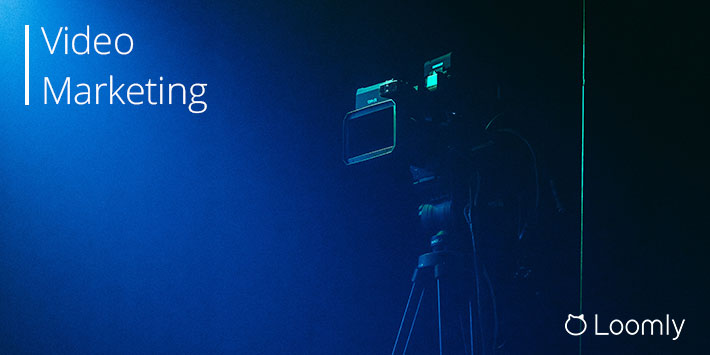Video marketing is taking the stage front and center.
Everywhere you look, the latest figures show an upwards trend in online video consumption.
A recent survey revealed that 27.2% of online viewers watched more than 10 hours of online video every week:
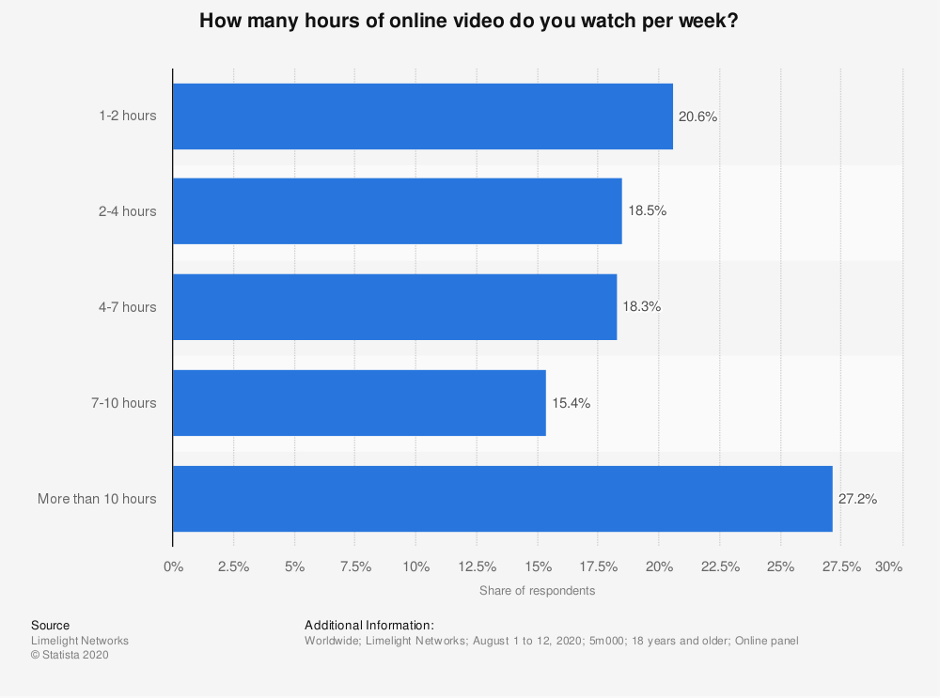
It’s a fact not lost on the social media networks as each platform from TikTok to LinkedIn and YouTube promotes more video-orientated content to satisfy user demand.
If you haven’t embraced video as part of your digital marketing strategy yet, then now is the time to reconsider.
In this guide, you’ll discover:
- What video marketing is.
- Why your brand should bet on video marketing.
- Four examples of successful video marketing campaigns.
- How to implement a winning video marketing strategy for your brand.
Let’s begin.
What is Video Marketing?
Video marketing involves using video to promote or market your brand, product, or service.
You can use different types of video, such as how-to videos, explainer videos, and customer testimonials, to reach your audience, raise awareness, increase engagement, and drive sales for your marketing campaign.
Types of marketing video
There are three broad categories of marketing video viewed by people in different places at different stages of the marketing funnel:
Awareness:
Social media videos attract new customers. They’re usually short video clips designed to play automatically with the sound off (but captions on) that show your brand’s personality.
Consideration:
Content marketing videos educate and entertain. You can expect to see explainer and how-to videos that show how your product or service helps solve a customer problem, plus thought leadership videos that establish you as a source of industry news and insight.
Decision:
Conversion videos nurture your prospects and build trust. By this stage, you can expect to see product demo videos, landing page videos, case studies, and customer testimonial videos. These are generally longer in duration compared to the short social media videos.
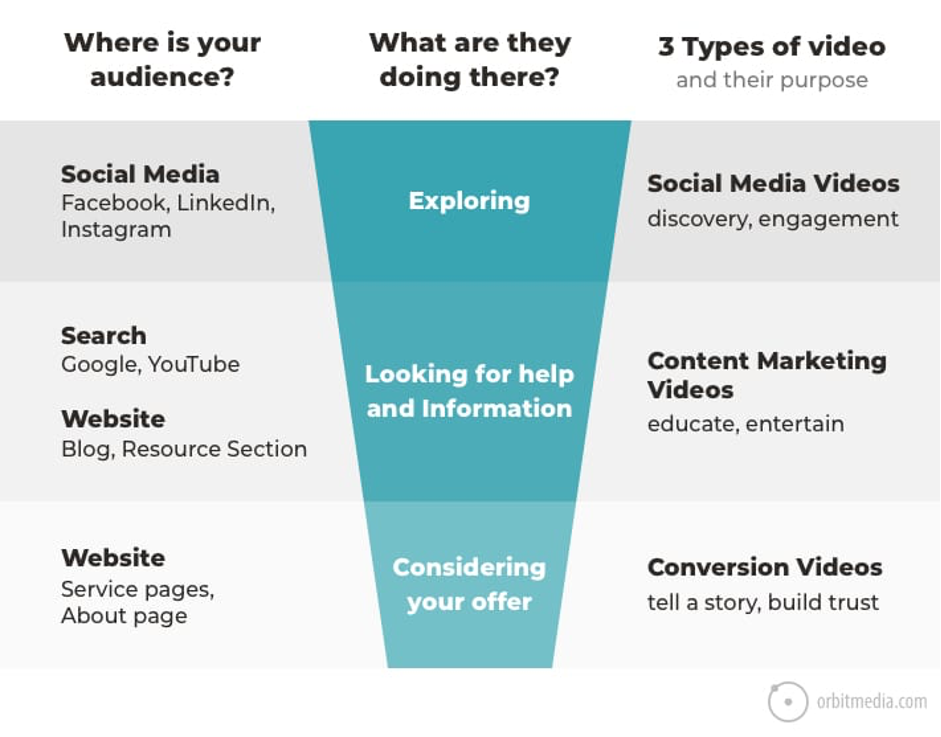
Why Your Brand Should Bet On Video Marketing Now
Wherever you look online, video is taking the stage front and center.
There are three main reasons why:
1. User expectations
People are watching more video content, whether that’s on their mobile or streamed to their TV. Let’s examine the figures:
Zenith estimates that the average person will spend 100 minutes every day watching online videos in 2021 — almost 19% more compared to 2019:
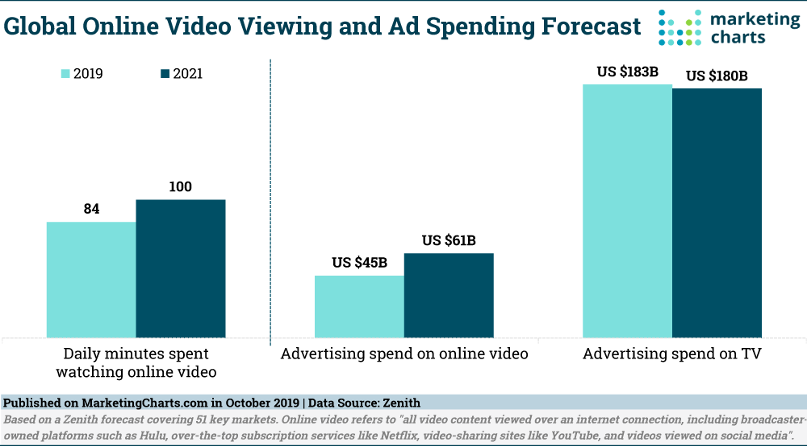
According to HubSpot Research, over half of consumers want to see videos from brands more than any other type of content:
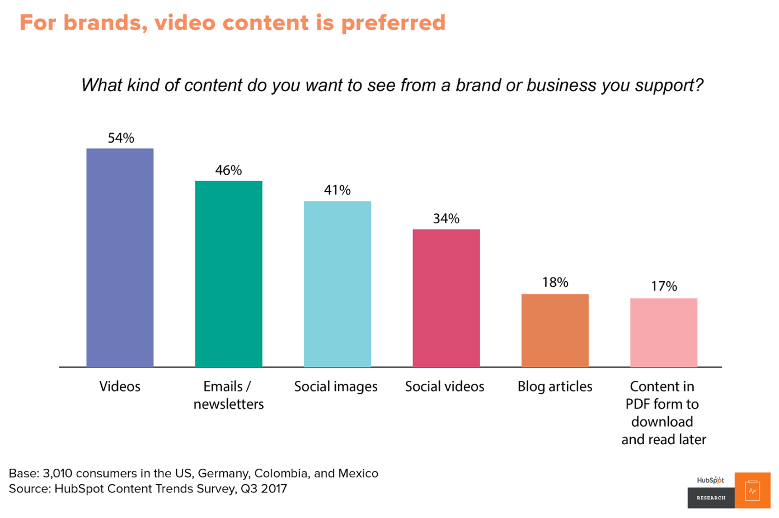
Google’s research shows that 6 out of 10 people prefer to watch online videos than television:

2. Social platforms
To meet user expectations, social media platforms have become “video first” and created video-friendly formats like Stories, Reels, and Live broadcasts.
Social media videos are typically short clips that you see in the respective Feed/Stream and are designed to grab your attention. But there are also longer formats, including live broadcasts, vlogs, customer testimonials, product demonstrations, and tutorial videos.
Video features and stats of each platform
Aside from native video posted to your timeline, each social platform has other video features.
Instagram: Stories, Reels, IGTV, and Live broadcasts.
- 60% of Instagram Stories are watched with the sound on.
- Posts containing videos receive about 38% more engagement than those containing images.
Facebook: Stories and Facebook Live.
- 85% of Facebook videos are watched without sound.
- 62% of people said they were more interested in a product after seeing it in a Facebook Story.
LinkedIn: Stories and LinkedIn Live.
- Video campaigns on LinkedIn have 50% view rates.
- LinkedIn Live videos get, on average, 7x more reactions and 24x more comments than native video.
Twitter: Fleets and Live broadcasts.
- Tweets with video see 10x more engagement than those without.
- People watch 2 billion videos on Twitter each day.
TikTok: Short videos with multi-effects.
- More than 1 billion videos are viewed on TikTok every day.
- An average TikTok user spends 52 minutes per day on the app.
YouTube: Multiple video formats, including live broadcasts and webinars.
- Every day people watch over a billion hours of video and generate billions of views on the platform.
- More than 70% of YouTube viewing time comes from mobile.
3. Technology advancement
The latest software, hardware, and infrastructure make video production and consumption easier.
Hardware progress: As 4K cameras bring higher quality video, content marketing and advertising through video continues to grow. You don’t have to hire videographers and studios to produce high-quality videos. You can use the latest smartphones to record 4k high-definition video.
Network evolution: As high-speed internet and 5G rolls out worldwide, more people have access to faster streaming. There’s close to 1 million minutes of video crossing the internet per second. Plus, by 2021, Cisco reckons online videos will account for more than 82% of all consumer internet traffic — 15 times higher than in 2017.
Software apps and tools: Today, it’s possible to record high-quality videos on your smartphone and post directly to social media platforms without creative skills or a large budget. Plus, there’s other free video editing software that allows users to create different types of videos.
To summarize, these developments mean that video is now easier to produce and is more popular to watch than ever.
Video marketing is effective and emotional as it makes a deeper human connection. It helps your audience:
- SEE your brand.
- HEAR your brand’s message.
- UNDERSTAND your brand’s ideas.
Examples of Successful Video Marketing Campaigns
Here are four examples of successful video marketing campaigns to inspire you.
Dollar Shave Club – Our Blades Are F***ing Great
Dollar Shave Club is a DTC subscription service for razor blades, priced at one dollar. There’s no hard-sell, but the video (which went viral) strikes the right balance between humor and information. They spent $4500 on this video and received 12,000 new orders within 48 hours of rolling it out.
GoPro – Fireman Saves Kitten
GoPro videos typically feature action-packed adventures of mountain climbers, skydivers, and surfers. But in this video marketing campaign, they switched emotions to a fireman equipped with a GoPro helmet camera saving a kitten. The different style of content allowed them to reach a broader audience.
Spotify – Montage
Animated explainer videos are short branded videos (on average, under 1-minute) commonly used to describe a product or service quickly and creatively. They allow brands to reveal their unique personality through custom illustration and animation styles. Spotify’s animated video was created to appeal to a global audience with wildly diverse tastes and attract potential Premium subscribers.
Applied Fitness Solutions – Kristina’s Success Story
Customer testimonial videos help to build trust with your brand. In this example, Applied Fitness Solutions shares a customer success story in which Kristina delivers her message in a genuine, personable way that makes the testimonial video feel and sound authentic and trustworthy.
How to Implement a Winning Video Marketing Strategy for Your Brand
Now you have an idea of what’s possible with video marketing, it’s time for you to implement your video marketing strategy with this 5-step guide:
- Align your business and video goals
- Plan your video content
- Produce your marketing videos
- Measure your performance
- Rinse and repeat
Step 1. Align your business and video goals
The first step in creating your video strategy is to align your business and video goals to the marketing funnel:
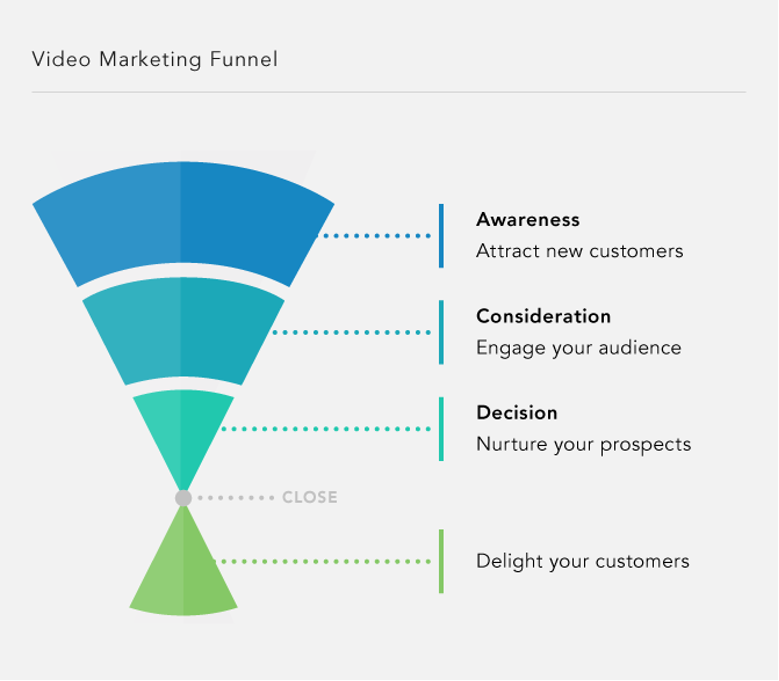
Credit: LemonLight.com
Awareness: Top of the funnel
Videos in the awareness stage should attract users and introduce your brand to a new audience.
You’ll want to set targets linked to the discovery of your brand, like total views, 3-second views, and view duration.
Consideration: Middle of the funnel
At this stage, viewers are researching how to solve their problem, so you’ll want to consider creating product/service videos and explainer videos.
You can use metrics such as click-through rate and view length:
- The click-through rate shows how many people were interested enough to click your video and go to your landing page.
- The view length shows the level of engagement (or interest) of your viewers.
Conversion: Bottom of the funnel
By now, viewers are almost ready to purchase your product or service, so it’s good to build trust with social proof through customer testimonial videos, plus explainer and product/service videos.
For your conversion videos, the most important metric is sales or sign-ups, but it’s also worth monitoring the click-through rate to see how many people visited your sales page but didn’t buy.
Delight: After sales
You can also create videos to delight customers who’ve already purchased your product or service. Consider producing beginner and advanced tutorials to help customers get the most out of your product or service.
Step 2. Plan your video content
The next step in creating your video strategy is to plan your content ahead of time to tell a consistent story.
Planning your story
There are four main elements to include in your story:
- Character: a person who aligns with your target audience.
- Conflict: your potential customer’s pain point.
- Quest: where you introduce your product or service.
- Resolution: where your product or service solves their problem.
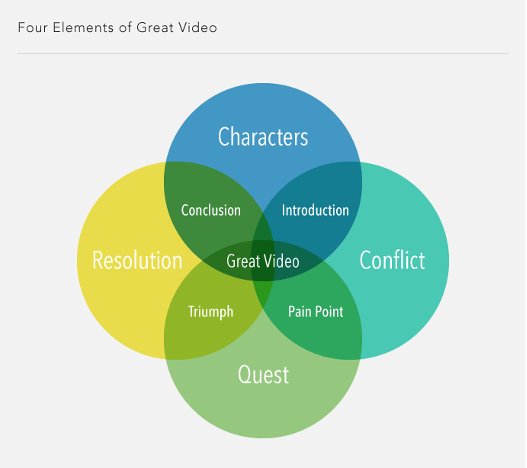
Credit: LemonLight.com
Telling a consistent story will take your viewers on a journey that unfolds with every new video.
Approval workflow
As you plan your content, make sure you build in an approval workflow and allow adequate time for each video creation stage. For example, you might need to include colleagues from other departments, such as:
- Creatives: any videographers, designers, or writers involved in creating the video.
- Sales: to check the correctness of any sales messages.
- Product: to check the accuracy of product information.
- HR: to ensure the content is in line with company policy.
- Finance: to ensure there are no budget issues.
- Legal: to ensure there are no liability issues.
- Third-Parties: any clients, agencies, or contractors you may be working with.
Editorial calendar
Aside from approvals, you’ll need to build your editorial calendar so that you get the right mix of content published at the right time.
Your video marketing calendar will most likely contain two types of content: organic and paid.
- Organic content refers to the videos you want your existing audience to see and come in the middle or bottom of the funnel.
- Paid content refers to the video ads you pay to run on search or social media and cover all levels of the funnel, from awareness to consideration to conversion.
Step 3. Produce your marketing videos
The next step in creating your video strategy is to produce your video content. There are three phases of video production:
- Pre-Production
- Production
- Post-production
The pre-production phase covers all your preparation before you start recording. You should have a good idea of what you want in the content from the planning section above. But you’ll also want to cover:
- Scripting your video, including dialogue, voice-over, music, visual and sound effects.
- Storyboarding can go into more detail with mockups of what you want to achieve.
- Hiring equipment, staff, and props.
The production phase is where everything comes together, and you get to create your video. You’ll want to ensure everything is right, including audio and visual quality, lighting, and styling.
The post-production phase is where you can add the finishing touches, such as visual, sound, and graphic effects. You’ll also want to consider adding captions (remember many videos, especially on social media, are played without the sound) and a call to action.
Self-producing a video
As mentioned earlier, with the advances in technology over the past decade, it’s now possible for anyone to produce videos.
There are a couple of options for video self-production:
- Video maker tools
These include tools like Biteable, InVideo, or Adobe Express, where you get a library of pre-made templates plus stock footage and images. These are the most straightforward tools to get started with and are suitable for producing videos for the top and middle of the funnel.
- Video editing tools
The next step up is to use video editing tools like iMovie, Adobe Premiere Pro, or Final Cut Pro, where you use your own footage and skills to produce more-refined videos.
Outsourcing video production
The other option is to outsource video production. If you don’t have the time or resources in-house, this is a safe option. Plus, you’ll also want to consider this option for producing more polished, bottom of the funnel conversion videos. At this stage, viewers will expect more refined production quality compared to the more raw, edgy social media videos.
Step 4. Measure your performance
In this step of your video marketing strategy, you need to review your video performance and see if you met the goals you set out in Step #1.
Based on the marketing funnel, here are the metrics to focus on at each stage.
Awareness: Attract new customers
At the top of the funnel, you want to attract new customers. You can focus on metrics like views, impressions, and unique users to see how many visitors you’re attracting.
- Views
- Impressions
- Unique Users
Consideration: Engage your audience
Now your audience knows about your brand, you need to keep them engaged. View duration and view-through rate are two of the most important metrics here as they indicate how engaging your video content is. You can also use metrics such as likes, comments, and shares to measure engagement when posting your video on social media.
- View Duration
- View-Through Rate
- Likes
- Comments
- Shares
Decision: Nurture your prospects
If you nurture your prospects successfully, you’ll see the results in conversions, including sign-ups to newsletters, free-trial subscriptions, and purchases.
- Clicks
- Calls
- Sign-ups
- Sales
Success: Delight your customers
The goal here is to keep customers interested in your brand for future purchases or added value. Focus on return visits and social engagement to see how much your brand is trusted and championed by your customers
- Return Visits
- Social Engagement
Step 5. Rinse and repeat
Finally, after reviewing the performance of your video content, you need to learn the lessons of what worked and what didn’t.
For example, if the view-through rate of your video is low, you could try creating a shorter version of the video to keep your audience engaged.
If you want to improve your video marketing campaigns, you need to fine-tune and adjust your content continuously.

Manage all your social media accounts in one place.
Craft, schedule, & auto-post content to all your social channels, then track analytics and manage interactions from a single, easy-to-use dashboard.
Video Marketing in a Nutshell
Video marketing is an essential part of digital marketing since more people now prefer to watch videos from brands than other types of content.
Video marketing can help your brand, product, or service to be SEEN, HEARD, and UNDERSTOOD by your target audience.
Follow this 5-step guide to implement your video marketing strategy:
- Align your business and video goals
- Plan your video content
- Produce your marketing videos
- Measure your performance
- Rinse and repeat
